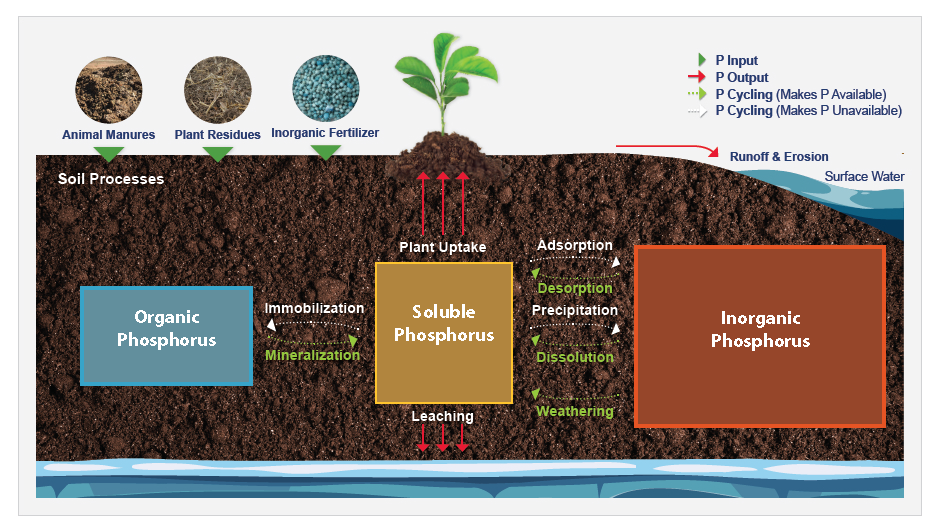My Phosphorus Saturation Is Low—Now What?
When considering environmental and economical risks, the best answer may not be as simple as “add fertilizer.”
Phosphorus (P) is one of many essential nutrients that plants take up from the soil in order to grow. In many cases it is the limiting nutrient, so P fertilizer is often applied. It is important to know how much P to apply because excess can be leached away or runoff with soil erosion, resulting in economic loss and environmental damage. Soil P can also be managed using liberating agents, which can convert existing soil P into forms usable by plants, and chelators, which help maintain phosphorus fertilizer in a plant-available form. At Trace Genomics, we developed the TracePHOS report to deliver the most comprehensive analysis of your soil P alongside actionable recommendations to help select the type of product that is most beneficial for your soil.
In the soil, P can be classified into 3 different categories:
- Organic forms that plants cannot use directly (compost, crop residue, manure, etc.)
- A soluble form that is readily available for plant uptake
- Inorganic forms that plants cannot access (bound to iron, aluminum, or calcium in soil particles)
Image 1. A modified version of the phosphorus cycle diagram created by the Alabama A&M and Auburn Extension service (1) showing the transformation of different types of phosphorus in the soil and which type is available to plants.
Soluble P taken up by plants only makes up approximately 6% of the total P in the soil (2) and is measured using traditional soil tests (Bray, Olsen, and Mehlich-3). The amount of inorganic insoluble P that a soil can hold is referred to as the soil phosphorus storage capacity (SPSC), and the P Saturation Level (Psat) displayed on your TracePHOS report is an indicator of how much of the storage capacity is utilized. This value is calculated on a scale from 0-100 where 100 is fully saturated.
If your starting Psat level is low, there is a high chance that any P fertilizer applied may be converted to inorganic forms through the processes of adsorption or precipitation, becoming unavailable to plants. In this case, it is beneficial to include a chelator in your fertilizer application to prevent P from transitioning to an unavailable, inorganic form. The chelator acts as a protective bubble around the soluble P fertilizer, preventing it from becoming bound. When a soil’s Psat level is high, any applied fertilizer is at a low risk of adsorption, and use of a chelator is less critical.
In addition to the chemical soil analysis and Psat, TracePHOS provides additional novel insights: how the biological component of your soil (microorganisms) can impact the amount of plant-available P. Microbes are able to create soluble P from both organic and inorganic sources, so application of a biological P liberation product could be helpful if those microbes are not already present in your soil microbiome. Research done by scientists at Trace Genomics has shown that application of P solubilizing microbes is most effective when Psat is high.
By incorporating guidance from TracePHOS into a soil fertility management plan, growers can optimize retention of soluble phosphorus, preventing loss through runoff and capture as inorganic compounds. This protects their valuable investment in soil nutrients and helps to maintain soil health for generations to come.
Key takeaway: when Psat values are low, any applied P fertilizer is at risk of being converted to an inaccessible, inorganic form. In this case, co-application of fertilizer with a chelator can prevent this transformation and keep the applied P in its soluble, plant-available form.
About the author: Dr. Tuesday Simmons is the Science Writer at Trace Genomics. She earned her Ph.D. in Microbiology from the University of California, Berkeley, studying the root microbiome of cereal crops.
References:
- Prasad, R., and Chakraborty, D. (2019). Phosphorus Basics: Understanding Phosphorus Forms and Their Cycling in the Soil. Alabama Cooperative Extension System. https://www.aces.edu/blog/topics/crop-production/understanding-phosphorus-forms-and-their-cycling-in-the-soil/.
- Menezes-Blackburn, D., Giles, C., Darch, T., George, T.S., Blackwell, M., Stutter, M., Shand, C., Lumsdon, D., Cooper, P., Wendler, R., et al. (2017). Opportunities for mobilizing recalcitrant phosphorus from agricultural soils: a review. Plant and Soil 427, 5–16. https://doi.org/10.1007/s11104-017-3362-2.






